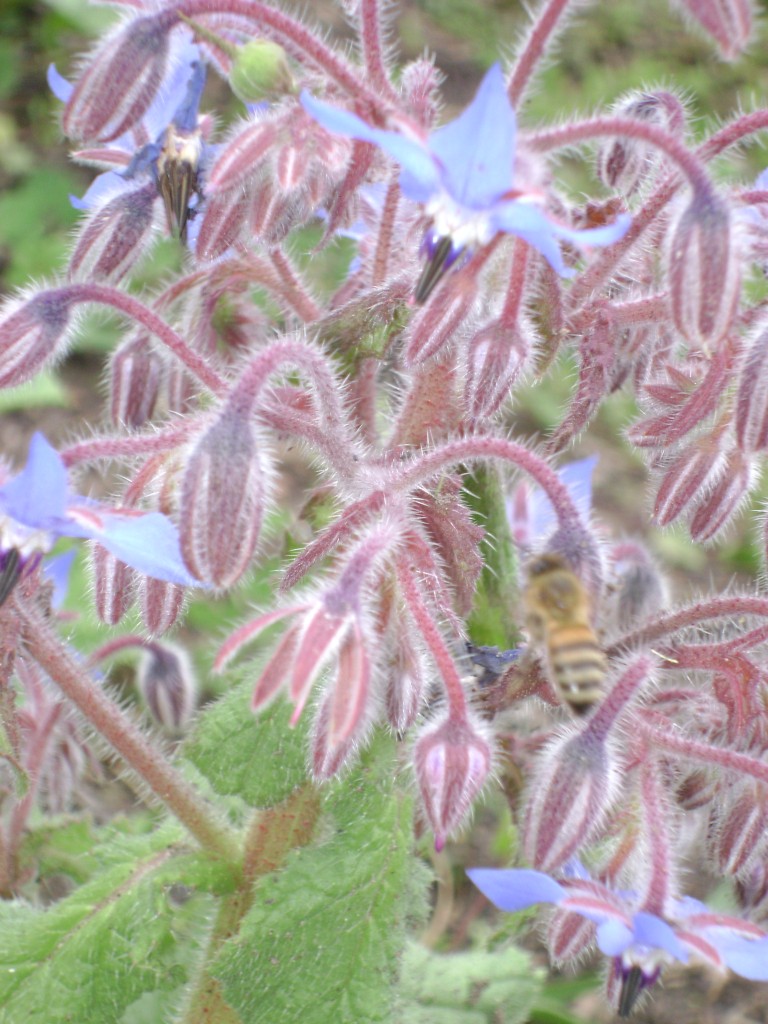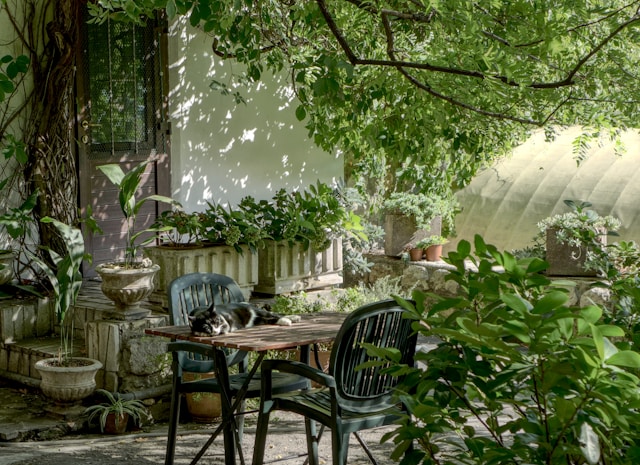Honeybees in Borage early February 2012
It has been confirmed by new studies that the Mass Die-Off of hundreds of thousands of Bees this spring being reported by farmers and Bee Keepers in states across American is due to pesticides. (See more as ABC News Reports)
I find it quite strange now after reading the new studies that have come out recently that prove pesticides as being the culprit for the mass die-off of our bees. Purdue University has stated that “Analyses of bees found dead in and around hives from several apiaries over two years in Indiana showed the presence of neonicotinoid insecticides, which are commonly used to coat corn and soybean seeds before planting. The research showed that those insecticides were present at high concentrations in waste talc that are exhausted from farm machinery during planting. “
You only need to be a gardener, much like myself to notice the detrimental loss of bees of all sorts. Not only do I see no honeybees, I’ve seen but a scant couple of Bumble Bees this year. While I have been very happy to see many wild bees come to pollinate my trees, I have none of the usual visitors. I don’t have to be a scientist to know that there is a very serious problem.
As I look back this season very early on in February as my Borage began blooming I had taken photos of lovely bees all about feasting upon the herbs nectar. But again I’ve come to realize that this was before all the thousands of acres of corn and cotton was planted here in Texas that commonly use neonicotinoid insecticides.
Pollinator Garden, end of May 2012
I’ve read recently that many farmers have now begun to depend greatly on the Wild Bees to pollinate their crops. I am concerned for them now as well because of the chemicals the farmers are using.
As you can see I have a whole lot of different Wildflowers and Native plants throughout my Pollinator Garden. I have hoards of butterflies and moths with only a few Wild Bees. I can only see my garden as a sanctuary for what bees there may be to recover and perhaps nourish them back to health.
As a few areas across our country may see more bees than others, it is said that is because those areas may not be as close to agricultural areas where the insecticides are prevalent. I actually see more bees in urban and city limits than what we have in our rural areas. As you come to realize the emergency set forth by massive bee deaths you may feel more inclined to get on board with efforts steered towards protecting them.
Many people have rushed in now across the country, learning how to raise their own beehives. If this might be something you are interested in, you can begin gathering information through your local county extension office. Some Master Gardening Groups also offer a member to set the hives up and maintain them for you on your property while you learn.
For many other people raising bees may not be an option, but gardening to nourish them back to health might be possible. Making it easy to begin a Pollinator Garden with a no-till method will get you off to a quick start.
Steps For Making An Easy No-Till Pollinator Garden
1. Purchase wildflower and native seeds that are specific to your zone. Flowering herbs and plants are perfect as well. Make sure they are all grown organically.
2. Select an area in your yard that will receive at least 6 hours of direct sunlight. Begin by laying out paper such as old grocery store bags or newspaper or even most feed sacks will work well. Wet it all down. This will begin the process of smothering out the existing grass or weeds. A black tarp or weed barrier will work for this part as well, but you will need to roll it up after several weeks out in the hot sun. It is still best to go ahead and lay out the wet paper as it is biodegradable.
3. Cover the paper with heavy composted material. Leaves, grass clippings, pine needles, and a compost pile go a long way. Lay the organic material thick. A foot is ideal for this. Water it all in really well.
4. Go ahead and plant your plants. Mulch very thickly. Scatter your wildflower seeds at the proper time for sowing in your garden zone.
5. Get creative with your designs. Make pathways between your new wildflower beds. Add water features and trellises. For more beauty, plan on planting each variety in massive groups. Keep the larger ones towards the back areas. Include small native trees and shrubs. Fruit and nut trees work very well. Don’t forget to include some common plants like sunflowers, old fashion marigolds, and zinnias.
Note: All pesticides, herbicides, and insecticides are reaping havoc on our important pollinators. Even organic pesticides can have alarming effects on the environment. The vast majority of Agricultural farms use pesticides. Some claim they are from a natural source and less toxic. Some may state that they are within the EPA guidelines and plant rows of wildflowers within their farms, but the chemicals they spray are still toxic to the bees. We must take a serious look at our behaviors and practices in agriculture. We should not invite pollinators into our fields to then cause them harm.
- Wild Dagga Motherwort Medicinal Herb - November 11, 2013
- Grow The Best Organic Lettuce - November 4, 2013
- Amish Hot Pepper Mustard - October 23, 2013


I have absolutely no room at the AZ house, but the next time I go back to San Diego, I’m going to do this in my back yard. I have about half an acre just waiting for a great project like this!
Oh Awesome Cherri!!! Keep me posted when you get it going!! How is your AZ garden doing now?
Your ideas regarding a natural garden sound really good. Bee-friendly habitat helps them get the variety of pollen needed for a complete diet. On the other hand, bees cover about 27,000 acres, which may be why they are being found more in suburban and urban areas than in intensely row-cropped regions.
I’m a beekeeper in Ohio, where some loss of bees also occurred this spring. Interestingly, no sign of pesticides was found in the multiple samples sent in for testing. That is still being debated, of course. The main reason for loss of wild or feral bees has been the varroa mite which showed up in the US in the late 80s. It decimated feral and managed honey bee colonies alike, and is still the reason why we don’t see feral bees very often. A hive may swarm and set up a colony in a tree for a year or two, but after that they most often succumb to the mites. Beekeepers adjust by raising more colonies in the spring–an expense to be sure, but a manageable one. Bees are not disappearing, media reports to the contrary. My page on FaceBook is Farmer Bill’s Produce & Honey–you’re welcome to join the group.
Thanks so much Bill for all your very useful information. I will certainly bee by to visit your page! It gets quite lonely out here in rural Texas without our bees. We greatly lacked bumblebees as well as the variety of wildbees. Honeybees we have lacked for years. So we’ve rather depended upon all the others for pollinating our gardens.